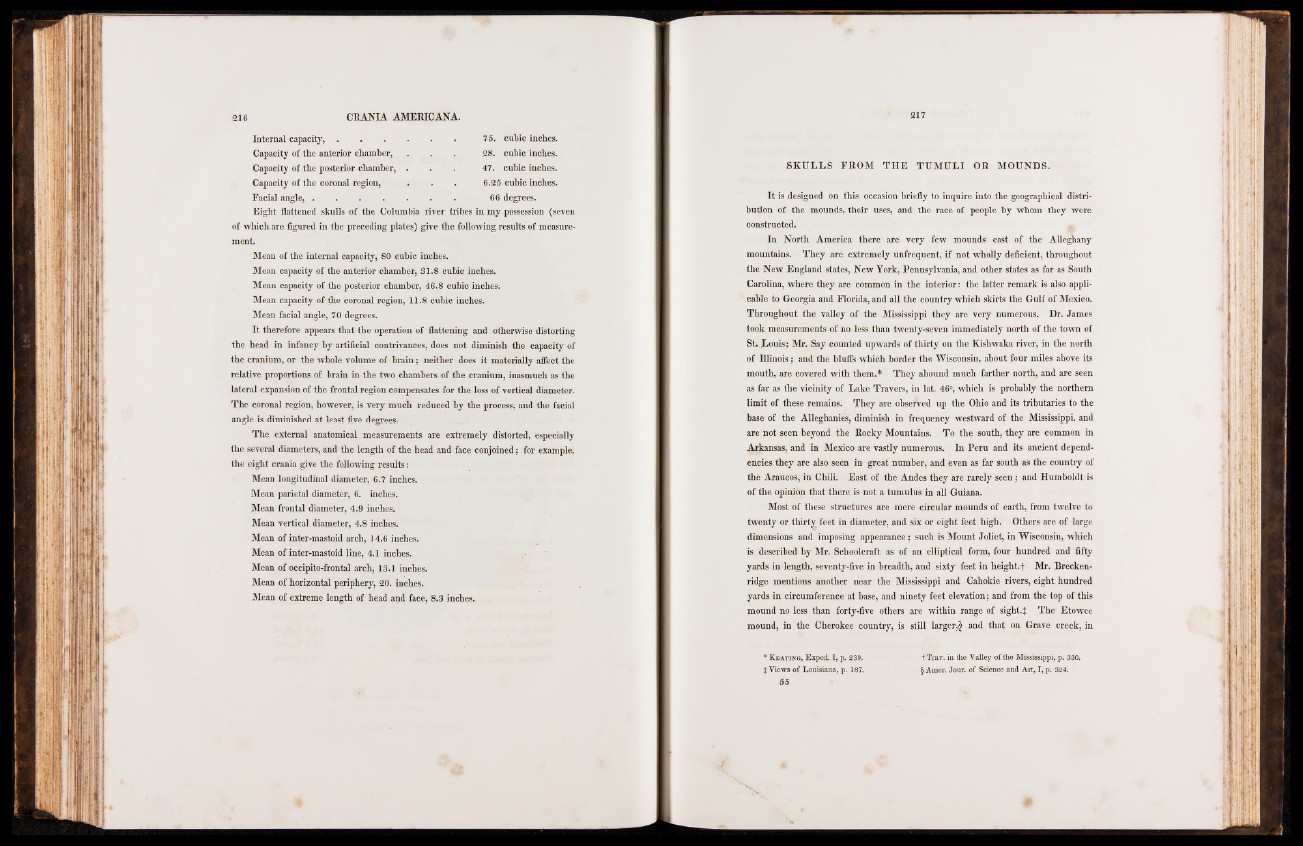
Internal capacity, . . . . . . 75. cubic inches.
Capacity of the anterior chamber, . . 28. cubic inches.
Capacity of the posterior chamber, . . . 47. cubic inches.
Capacity of the coronal region, . . 6.25 cubic inches.
Facial a n g le ,...................................... . . 66 degrees.
Eight flattened skulls of the Columbia river tribes in my possession (seven
of which are figured in the preceding plates) give the following results of measurement.
Mean of the internal capacity, 80 cubic inches.
Mean capacity of the anterior chamber, 31.8 cubic inches.
Mean capacity of the posterior chamber, 46.8 cubic inches.
Mean capacity of the coronal region, 1 1 .8 cubic inches.
Mean facial angle, 70 degrees.
It therefore appears that the operation of flattening and otherwise distorting
the head in infancy by artificial contrivances, does not diminish the capacity of
the cranium, or the whole volume of brain; neither does it materially affect the
relative proportions of brain in the two chambers of the cranium, inasmuch as the
lateral expansion of the frontal region compensates for the loss of vertical diameter.
The coronal region, however, is very much reduced by the process, and the facial
angle is diminished at least five degrees.
The external anatomical measurements are extremely distorted, especially
the several diameters, and the length of the. head and face conjoined; for example,
the eight crania give the following results:
Mean longitudinal diameter, 6.7 inches.
Mean parietal diameter, 6. inches.
Mean frontal diameter, 4.9 inches.
Mean vertical diameter, 4.8 inches.
Mean of inter-mastoid arch, 14.6 inches.
Mean of inter-mastoid line, 4.1 inches.
Mean of occipito-frontal arch? 13.1 inches.
Mean of horizontal periphery, 20. inches.
Mean of extreme length of head and face, 8.3 inches.
SKULLS FROM TH E TUMULI OR MOUNDS.
It is designed on this occasion briefly to inquire into the geographical distribution
of the mounds, their uses, and the race of people by whom they were
constructed.
In North America there are very few mounds east of the Alleghany
mountains. They are extremely unfrequent, if not wholly deficient, throughout
the New England states, New York, Pennsylvania, and other states as far as South
Carolina, where they are common in the interior: the latter remark is also applicable
to Georgia and Florida, and all the country which skirts the Gulf of Mexico.
Throughout the valley of the Mississippi they are very numerous. Dr. James
took measurements of no less than twenty-seven immediately north of the town of
St. Louis; Mr. Say counted upwards of thirty on the Kishwaka river, in the north
of Illinois; and the bluffs which border the Wisconsin, about four miles above its
mouth, are covered with them.* They abound much farther north, and are seen
as far as the vicinity of Lake Travers, in lat. 46°, which is probably the northern
limit of these remains. They are observed up the Ohio and its tributaries to the
base of the Alleghanies, diminish in frequency westward of the Mississippi, and
are not seen beyond the Rocky Mountains. To the south, they are common in
Arkansas, and in Mexico are vastly numerous. In Peru and its ancient dependencies
they are also seen in great number, and even as far south as the country of
the Araucos, in Chili. East of the Andes they are rarely seen; and Humboldt is
of the opinion that there is not a tumulus in all Guiana.
Most of these structures are mere circular mounds of earth, from twelve to
twenty or thirty feet in diameter, and six or eight feet high. Others are of large
dimensions and imposing appearance; such is Mount Joliet, in Wisconsin, which
is described by Mr. Schoolcraft as of an elliptical form, four hundred and fifty
yards in length, seventy-five in breadth, and sixty feet in height.f Mr. Brecken-
ridge mentions another near the Mississippi and Cahokie rivers, eight hundred
yards in circumference at base, and ninety feet elevation; and from the top of this
mound no less than forty-five others are within range of sight.f The Etowee
mound, in the Cherokee country, is still larger,§ and that on Grave creek, in
* Keating, Exped. I, p. 239.
% Views of Louisiana, p. 187.
55
t Trav. in the Valley of the Mississippi, p. 330.
§ Amer. Jour, of Science and Art, I, p. 324.